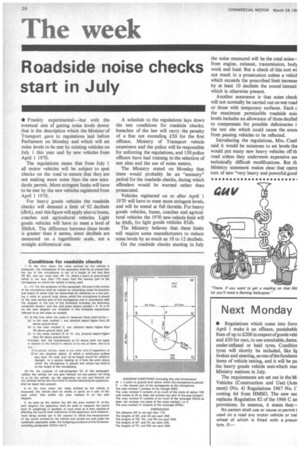Roadside noise checks start in July
Page 28

Page 29

If you've noticed an error in this article please click here to report it so we can fix it.
• Frankly experimental—but with the eventual aim of getting noise levels down: that is the description which the Minister of Transport gave to regulations laid before Parliament on Monday and which will set noise levels to be met by existing vehicles on July 1 this year and by new vehicles from April 11970.
The regulations mean that from July 1 all motor vehicles will be subject to spot checks on the road to ensure that they are not making more noise than the new standards permit. More stringent limits will have to be met by the new vehicles registered from April 1 1970.
For heavy goods vehicles the roadside checks will demand a limit of 92 decibels (dbA), and this figure will apply also to buses, coaches and agricultural vehicles. Light goods vehicles will have to meet a level of 88dbA. The difference between these levels is greater than it seems, since decibels are measured on a logarithmic scale, not a straight arithmetical one. A schedule to the regulations lays down the test conditions for roadside checks; breaches of the law will carry the penalty of a fine not exceeding £50 for the first offence. Ministry of Transport vehicle examiners and the police will be responsible for enforcing the regulations, and 150 police officers have had training in the selection of test sites and the use of noise meters.
The Ministry stated on Monday that there would probably be an "amnesty" period for the roadside checks, during which offenders would be warned rather than prosecuted.
Vehicles registered on or after April 1 1970 will have to meet more stringent levels, and will be tested at full throttle. For heavy goods vehicles, buses, coaches and agricultural vehicles the 1970 new-vehicle limit will be 89db, for light goods vehicles 85db.
The Ministry believes that these limits will require some manufacturers to reduce noise levels by as much as 10 to 12 decibels.
On the roadside checks starting in July the noise measured will be the total noise— from engine, exhaust, transmission, body work and load. But a check of this sort wi not result in a prosecution unless a vehicl which exceeds the prescribed limit increase by at least 10 decibels the sound intensit which is otherwise present.
Another assurance is that noise check will not normally be carried out on wet road or those with temporary surfaces. Each c the maximum permissible roadside nois levels includes an allowance of three decibel to compensate for possible deficiencies i: the test site which could cause the soun from passing vehicles to be reflected.
Introducing the regulations, Mrs. Castl said it would be nonsense to set levels tha would put many new heavy vehicles off th road unless they underwent expensive am technically difficult modifications. But th Ministry statement makes clear that opera tors of new "very heavy and powerful good vehicles" may need to have sound-deadening kits fitted and that makers have these available. (It is already known that Dodge is offering quietening kits for V8-engined models.) The new regulations (Motor Vehicles (Construction and Use) (Amendment) Regulations 1968 No. 362) are available from HMSO price Is 6d., or through booksellers. They stem from the Wilson Committee Report of 1963, but because international noise-measuring regulations have changed, and because the subsequent generation of very heavy goods vehicles has had noisier and more powerful engines, the levels recommended in the Wilson Report (85db for new vehicles, 88db for existing vehicles on the road) have had to be adjusted.
Now that limits have been set, testing, enforcement and actual prosecution procedures will gradually be developed. The Ministry states that under the roadside check procedure the prosecution witness will give evidence that the vehicle indicated a noise level which exceeded the limit laid down, that the background noise was not in excess of the prescribed limits, and that the site fulfilled the requirements, and so on.
The Schedule setting out the site requirements is reproduced opposite.
























































































































